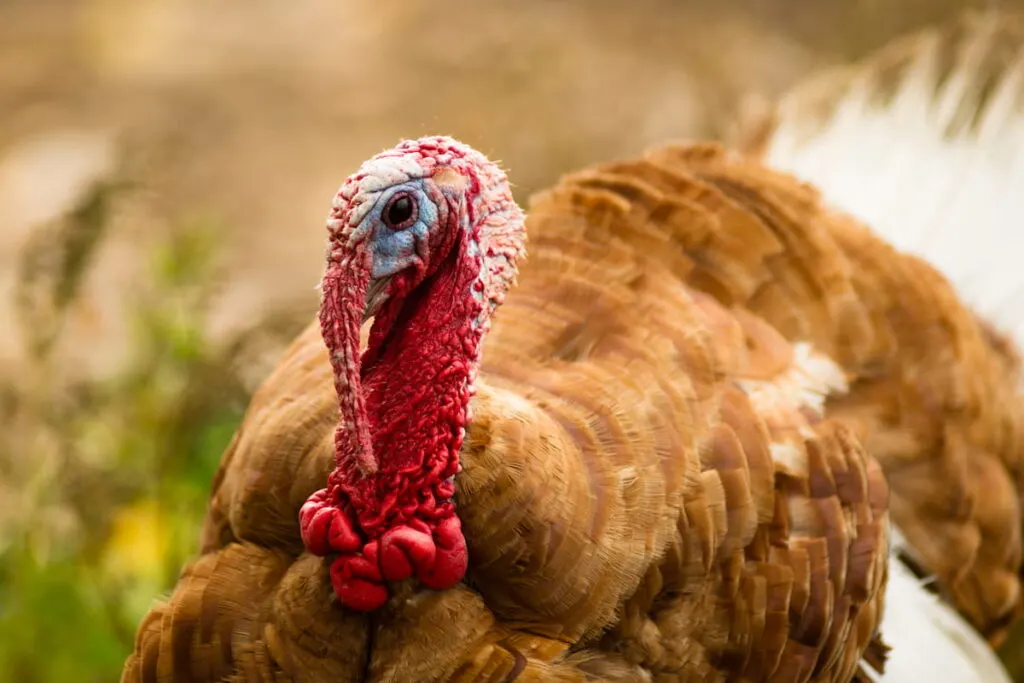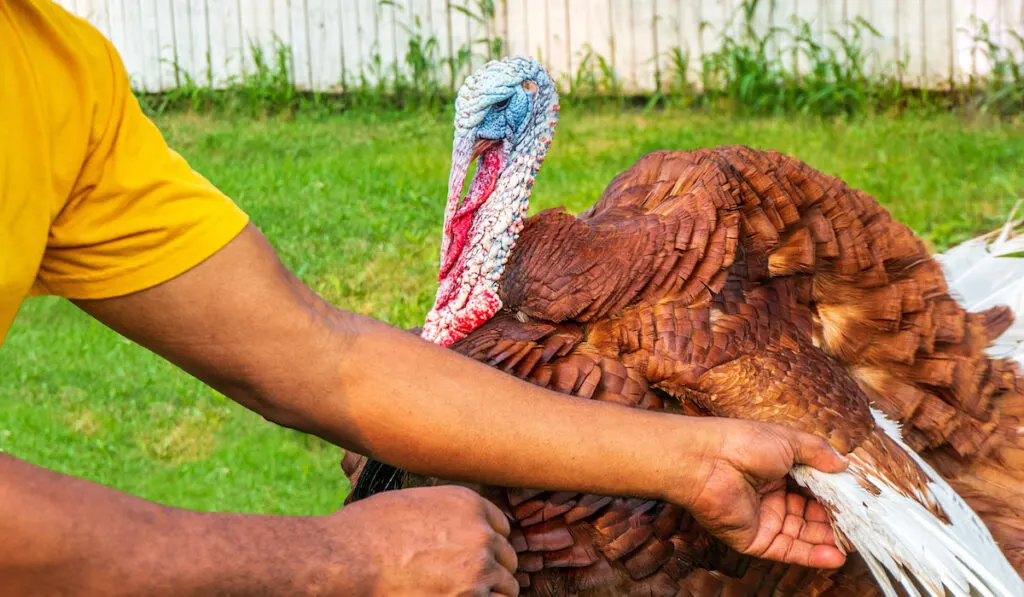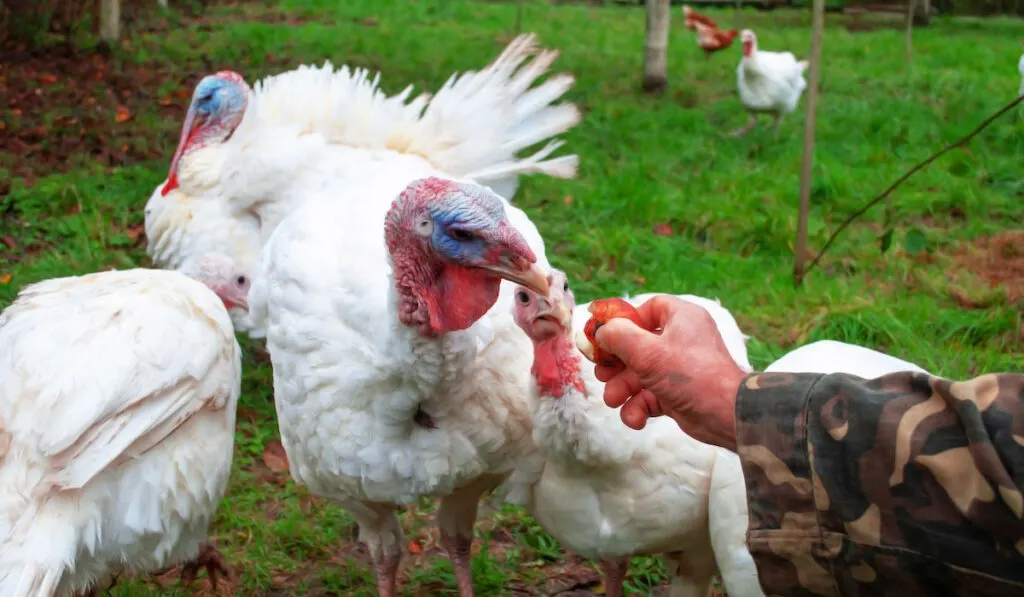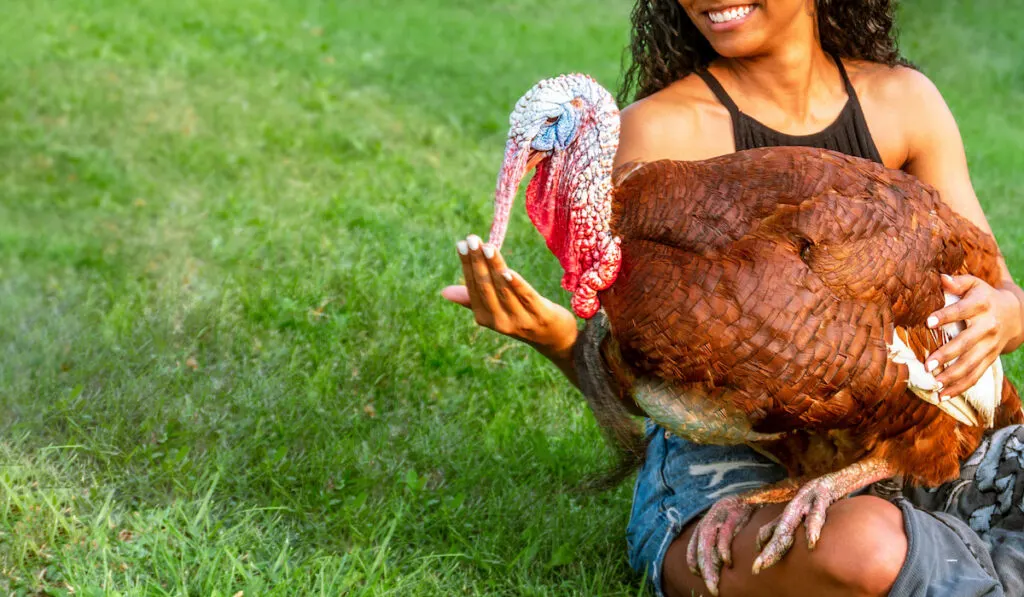Pet turkeys may seem like an unusual choice for a companion animal.
Surprisingly, they have become increasingly popular among those looking for low-maintenance pets that adapt well to outdoor living.
To pet a turkey, approach the bird calmly and gently to avoid startling it. Begin by slowly extending your hand toward the turkey’s head and neck area, then gently stroke the turkey’s feathers, starting from the neck and moving toward the tail.
This article will explore how to pet a turkey and what they need to thrive in a domestic setting.
Let’s dive in and learn how to interact properly with these fascinating birds.

Table of Contents
Ask Permission
It is crucial to seek the owner’s or caretaker’s consent before approaching a turkey. The owner might have specific guidelines or apprehensions about the turkey’s conduct.
When seeking approval, being courteous and expressing your intentions are essential. Kindly inform the owner of your desire to interact with their turkey and inquire if it is permissible.
If they permit you, ask if there are any specific guidelines or rules you should follow while interacting with the turkey.
Remember, it’s important always to prioritize the safety and well-being of the turkey and respect the wishes of the owner or caretaker.
How to Read Turkeys’ Body Language
To appropriately pet a turkey, it is crucial to comprehend its nonverbal communication.
Turkeys convey messages through several physical indicators, including their mannerisms, vocalizations, and gestures.
A clear understanding of these signals can assist you in assessing a turkey’s level of ease or anxiety. Here is some of the body language you can look at:

Color of the Head
The coloring of a turkey’s head is subject to change based on its emotional state.
In a serene state, their head appears blue, while it takes on a red hue during agitation or anger. Similarly, white is the coloration when the bird feels scared or is under stress.
Look at the Snood
In a calm state, a turkey’s snood will be smaller and occupy less space. However, when they are disturbed or attempting to attract a mate, their snood will extend and become more notable.
What to Do to Pet a Turkey
Step 1: Approach
First and foremost, it is important to approach the turkey slowly and calmly, so as not to startle it.
When you are close to the turkey, it is recommended to reach out your arm gradually and let the bird approach you in its own way.

Step 2: Touch and Bond
Gently stroke it along the back and neck and avoid sudden or jerky movements.
Refrain from touching birds’ head or tail feathers, as these body parts can be quite delicate and sensitive.
Step 3: Body Language
Be mindful of the turkey’s body language. This can give you clues as to whether it is feeling comfortable or stressed.
Ways To Keep Your Turkey Happy and Well-Petted
If you’re a turkey owner, here are ways to keep your turkeys happy and more likely to enjoy being petted.

Feed & Water
Turkeys consume a diet similar to chickens but in larger quantities due to their rapid growth rate. Feed your turkeys at least once daily, and ensure the diet has a balanced mix of grains and protein.
Poultry feed pellets are a viable choice due to their comprehensive vitamin and mineral content. However, you can also supplement their diet with fresh fruits and vegetables.
Turkeys enjoy a variety of produce, such as apples, berries, carrots, and leafy greens.
Turkeys also require constant access to clean and fresh water. This is especially important during summer when they are more susceptible to dehydration.
Make sure to regularly clean and refill their water containers to ensure that they are drinking clean water.
Living Spaces

When it comes to living spaces, turkeys require ample space to move around and stretch their wings.
Domestic turkeys that cannot fly can be kept in a fenced-in yard. However, for those that can fly, providing some type of netting is important to keep them in.
Depending on the breed and size of the turkey, 2 turkeys can occupy 90 square feet of space with a height of about 6 feet.
If you can improve the living space for the turkeys to move around and exercise, the better. Domestic turkeys are active birds and require ample space to roam and forage.
Turkeys Can Coexist With Chickens and Other Livestock
Turkeys are social birds and can easily coexist with other livestock, including chickens, ducks, and geese. In fact, they often form close bonds with other birds and enjoy spending time with them.
However, it’s important to introduce turkeys to other livestock gradually to avoid any potential conflicts.
When introducing turkeys to other birds, it’s best to keep them in separate enclosures for a few days to get used to each other’s presence.
Once they seem comfortable, you can start letting them out together under supervision.

FAQ
The best turkeys for pets include the Bourbon Red Turkey, Bronze Turkey, Norfolk Black, White Holland, and Midget Small White, as well as, Beltsville Small White, Royal Palm Turkey, and Narragansett Turkey.
Turkeys will peck at you when they feel scared or threatened. Turkeys can respond aggressively if their nesting space is invaded or if they sense they are trapped.
It is advisable to maintain a safe distance from them. If you are close to a turkey, it is recommended to calmly and gradually move away from the area.
Turkeys will follow you around to seek your approval or bonding. Turkeys are also curious, social in nature, and highly attuned to other beings’ presence.
Resources
- https://www.azurefarmlife.com/farm-blog/raising-turkeys-as-pets
- https://thehipchick.com/friendliest-turkey-breeds/
- https://petkeen.com/do-turkeys-make-great-pets/
- https://poultry.extension.org/articles/getting-started-with-small-and-backyard-poultry/housing-for-small-and-backyard-poultry-flocks/space-allowances-in-housing-for-small-and-backyard-poultry-flocks/
- https://montanadecoy.com/blog/how-to-read-a-turkeys-body-language/
- https://a-z-animals.com/blog/do-turkeys-make-good-pets/
- https://www.communitychickens.com/turkey-talk-5-things-to-know-about-pet-turkeys/
